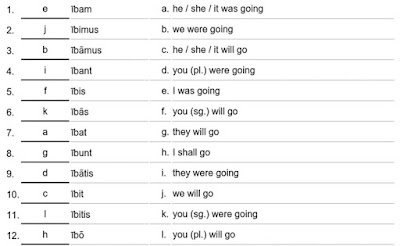Both of these tenses were covered in far earlier posts and reviewed recently.
[images #1 and #2] eō, īre
in [i] the imperfect tense and [ii] the future tense. That’s what I saw when I
started to learn Latin, and every grammar book will do the same.
As always, one of the
challenges of Latin is that the words all look very similar, and it’s easy to
misread them. But take it apart. What is it you need to look for?
Latin verbs are made up of
‘components’, just like a piece of electrical equipment. A Latin verb has three
components and those three components do in a single word what an English verb
sometimes needs to do in two, three or more separate words.
Take it apart:
īre: infinitive; to go
Remove the ending -re >
ī- ; that’s the stem, like the stem of a flower. It looks odd to
have a single letter stem, but that’s what it is: go i.e. [1] the base
meaning of the verb
Latin then gives two further
pieces of information: [2] the tense and [3] the person or
thing that’s performing the action.
[2]
Either [i] Imperfect tense
i.e. I was going, you were going etc. or I used
to go etc. Latin uses the imperfect tense markers: -ba-
/ -bā-
Or [ii] The future
tense markers: -bō / -bi- /-bu- I shall,
you will etc. dosomething
[3]
Then the personal
endings are added
-ō / -m: I
-s: you (sg.)
-t: he / she / it
-mus: we
-tis: you (pl.)
-nt: they
Examples:
[1] ī -ba-m │
I was going
[stem ī + │ imperfect marker
-ba -│ + person -m (I) ]
[2] ī-bi-mus │ we will go
[stem ī + │ future marker
-bi -│ + person -mus (we)]
[4] Follow the steps and try
the match up exercise. The answers are below the exercise.
It doesn’t matter how you learn something as long as it works for you …
[i] The image of the ‘imperfect sheep’ … -ba-, -bā- ... is used by some people to remember the
imperfect tense of almost every verb in Latin!
[ii] I remembered the future tense of two verb conjugations -bō, -bi- and -bu - by this rather odd book
title!





